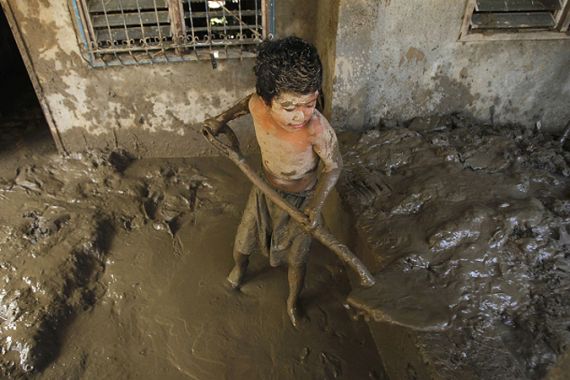Disease fears in Philippines after floods
Health official says crowded evacuation centres could be breeding ground for epidemics as typhoon death toll tops 1,000.

A Philippines government official has warned of the growing threat of disease in crowded evacuation centres, after devastating flash floods in the country’s south left more than a thousand people dead and scores more displaced.
The national disaster agency said on Wednesday that 1,002 people were now confirmed killed and dozens remained unaccounted for on Mindanao island since Tropical Storm Washi hit in the early hours of Saturday.
Keep reading
list of 4 itemsAfter the Hurricane
World’s coral reefs face global bleaching crisis
Why is Germany maintaining economic ties with China?
|
“If there is any epidemic or threat to health, it will come from the evacuation centres“ – Eric Tayag, |
About 44,000 people who have lost their homes are living in makeshift relief centres with inadequate food, drinking water or toilet facilities, while Philippines President Benigno Aquino has called the disaster a “state of calamity”.
While the death toll climbed, a senior health official said on Wednesday that relief efforts should focus on the evacuation centres which he described as potential breeding grounds for epidemics.
“We may be paying so much attention to the corpses we will ignore the evacuation centres,” Eric Tayag, the country’s assistant health secretary, said in an interview on ABS-CBN television.
“If there is any epidemic or threat to health, it will come from the evacuation centres,” he said.
In recent days, local authorities in the heavily hit port cities of Cagayan de Oro and Iligan have struggled to deal with hundreds of decomposing bodies which have created an overpowering stench.
Authorities buried dozens of bodies in concrete vaults on Wednesday.
Richard Gordon, Philippine Red Cross chairman, said the devastation in the affected areas was unprecedented. The organisation is appealing for $2.8m to help flood victims in the country.
“I’ve gone through many disasters but this one is the worst as some of the survivors have lost so many family members,” Gordon said. “Some have lost as many as 30 relatives.”
Overcrowded relief centres
In Iligan, some of the displaced headed back to their villages to reclaim their lives and rebuild destroyed houses.
Television footage showed residents shovelling mud, washing furniture and hanging clothes to dry under the sun.
“We have no other place to go but to our old homes,” a woman who only gave her name as Marina told local ANC television, saying the evacuation centres were too crowded for her family.
 |
| Authorities buried dozens of bodies in Iligan, one of two port cities devastated by flash floods [AFP] |
“We have to get on with our lives, rebuild our house and forget this tragedy. We appeal to the kindhearted to give us
lumber and galvanised iron so we can build a new home.”
Some of the displaced spent the night on pavements due to overcrowding in schools, churches, gymnasiums and army bases, raising public health concerns due to poor sanitation and lack of drinking water.
Nestor dela Cruz, whose two-storey house was swept to the sea, appealed to the government to relocate his family and his neighbours to a safer place. About 70 per cent of houses in his village were either destroyed or badly damaged.
“We’re returning to our village, but, we would welcome help from the government if they can give us land and build us new houses.”
Benito Ramos, a retired general and head of the national disaster agency, said it may take time to build new communities for the displaced as they focus on search, relief and recovery operations.
“Core shelters may take time to build because of the requirements involved,” Ramos told a radio interview. “There are
environmental clearances to secure and you have to show the locations is not prone to floods or landslides.”
Jesse Robredo, the Philippines interior secretary, said the president gave local officials at least 50m pesos ($1.14m) to begin building new houses in the two cities.